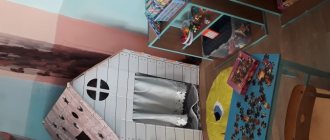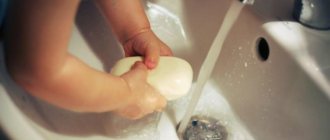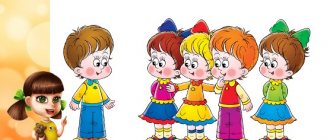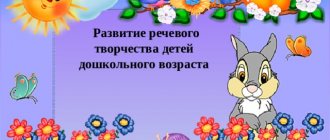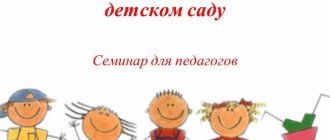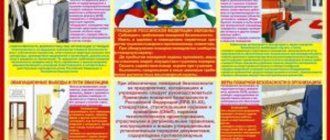Design in kindergarten
Author:
Petrova Marina Sergeevna,
teacher of the highest category,
teaching experience - 20 years,
Tobolsk, CRR preschool educational institution No. 40
| Happiness is multifaceted, but it is impossible to be happy if you lose the sense of color, the desire to create, the desire to create beauty. Preschool childhood is a fertile time for cultivating the tree of goodness and beauty. Children enthusiastically sing and dance, sculpt and draw, compose music and fairy tales, and engage in folk crafts. Creativity helps a child learn to see beauty and goodness in the world around him, makes the child’s life richer, fuller, more joyful. But how can we teach preschoolers kindness, patience, and the desire to help others? How to convey to him the intellectual wealth of his ancestors? How not to lose that ability - the ability to speak with your child in the same language - the language of art? L.S. Vygotsky said: “Creativity is not the destiny of only geniuses who created great works of art. Creativity exists wherever a person imagines, combines, creates something new.” Based on the statements of L.S. Vygotsky, |
Children's design represents enormous potential and great opportunities for the development of creativity, fantasy and imagination.
Children's design is aimed at revealing the child's personality, his individuality, the development of his creative potential, free, without pressure from an adult, based on the child's self-expression, his self-development, cooperation and co-creativity, using only humane methods and techniques, without prohibitions and categorical appeals .
| Our kindergarten No. 40 - Child Development Center works in this direction, which aims to foster an emotional and conscious attitude towards art. Education of color and emotional perception, study of the laws and rules of visual literacy, development of observation and analytical thinking, familiarization with the basics of design activity, education of an inquisitive person who is not indifferent to the world around him, who knows how to creatively and constructively approach solving life problems - we solve these problems in our kindergarten. |
The first steps into the art of design are so simple that they do not require much effort from the child. He discovers the world of matter with pleasure. Gradually, experience will come, skills will be formed, and he will easily complete a large, complex work on his own. In addition, today, more than ever before, there is a need for the formation of a harmoniously developed personality. A person who will study, protect and develop the spiritual heritage of our people. All this is of lasting importance: a person who sees and knows how to appreciate beauty will preserve and increase it; such people are not capable of immoral acts. That is why design classes are so relevant in our kindergarten - the activities of older preschoolers.
Our garden has been working on the problem of developing children's creative abilities through familiarization with design for five years. In search of unconventional methods and technologies, we use the programs: I. Lykova “Colored Palms”, “Origins”, manuals by G.N. Davydova, G. Panteleeva, I. Lykova, practical magazine “Colored World”. We are discovering new approaches to familiarizing ourselves with design activities. They are aimed at enhancing the development of the child. We build the initial process of introducing preschoolers to design activities on a good emotional basis. Surprise, admiration, joy from being introduced to art are feelings that need to be evoked in children.
The main goal that we set when working with children is to introduce children to the observation of reality, to develop the most important skills for artistic creativity, to see the world through the eyes of an artist, to develop observation and attentiveness, to provide freedom in reflecting – using artistic means accessible to the child – their vision of the world.
We visit museums, get acquainted with the exhibits on display, travel to the forest, park, excursions around the city, visit the theater, exhibitions, observe the world around us, the child discovers all its diversity, receives joy from this discovery and realizes his capabilities in realizing his vision.
Design is an activity that is a special type of artistic activity that combines various types of creativity: drawing, modeling, appliqué, design, artistic work.
In childhood, artistic ideas are stable and the child is able to take on any role of “artist”, “sculptor”, “designer”. He is able to motivate the choice of material to convey mood and emotional attitude to the world around him.
Famous and beloved characters come to visit preschoolers during classes, children get acquainted with the life and work of artists and sculptors, we conduct conversations, stories, fantastic stories, and use musical and poetic images in our work.
In order to test the assimilation of terms, concepts and as a psychological relief, we play games: “Young Designer”, “Decorate a Suit”, “Design an Interior”, “Replace Objects”, “Merry Color”, “Art Salon”, etc. We introduce preschoolers to various new methods and technologies used in design:
“Scrapebooking”, “Remake”, “Decoupage”, “Pescography”. We teach the ability to design clothes, while developing aesthetic taste, artistic outlook, understanding of clothing design as a creative process, acquiring knowledge and skills in creating clothing models. Children acquire knowledge about the theoretical foundations of costume design; about the patterns of visual perception in a suit.
We introduce you to architectural and artistic design and modeling of objects with arrangements and decorations made of different materials.
We teach children to explain, reason, compare, give complete answers; our children are happy to tell what they did, how they did it, and what happened as a result.
The world of things around us is very diverse. There are objects that serve us for a long time, and there are those that become unnecessary. They are called waste material. These include a variety of plastic bottles, caps, corks, chocolate egg cases, yogurt containers, buttons, beads, wire and much more, which we adults most often try to quickly get rid of and throw in the trash. But even unnecessary things acquire a second life if you try to see something unusual in them. We just need to fantasize, use our imagination, and teach our children this.
The variety of natural materials (cones, acorns, branches, seeds, grass, etc.) and ease of processing allow it to be widely used in working with preschoolers.
Observing children's creativity, you can see the importance the child attaches to his “riches” (pebbles, beads, scraps of fabric, buttons, etc.). In our opinion, these are unnecessary things - rubbish, garbage, but in children's hands they turn into real “jewels” - a bead is a pearl from a distant blue sea, a scrap is a princess dress, a candy wrapper is a tropical butterfly. It is this ability to see the unusual in the ordinary that we use in children's design classes.
The garden has a beauty corner (crafts made by children independently or together with teachers or parents), a permanent exhibition of children's works, creativity corners, reproductions of paintings, books about art. We introduce children to various types of activities, their characteristics and history.
Uniting educators, children and parents in joint work to introduce them to the world of creativity makes it possible to improve the pedagogical preparedness of parents in raising their own children, and helps to expand the forms of cooperation between family and kindergarten.
Our garden hosts “Master Classes”, “Parent Designer”, and takes part in the “Theatrical Mask” and “Candy Season” projects. costumes were made from waste material, the presentation “How beautiful this world is”, crafts, compositions from different materials, “Miss 2009” with the participation of children and parents, “Colorful flower garden” decoration in the areas was a great success. Parents of students help us a lot in mastering new technologies. They themselves are interested in this and in their free time they come to the group and help us. Parents prepare different materials. They are included in creative projects carried out in our garden. They go with their children to the forest and park, observing natural phenomena. They consolidate their acquired knowledge and skills in depicting objects at home. Practice “difficult” techniques with the child. Without the help of our parents we would not have achieved results.
In the course of creative activity, the little master makes many discoveries and achieves personal achievements. Although objectively he does not create anything completely new or unknown, the result of his work is subjective in nature, since this process itself contains its primacy for the child.
| The result obtained is the first and very important step in children's creativity. Making products with your own hands is a universal educational tool that can balance the one-sided intellectual activity of a small person so that he develops comprehensively. Design activities are designed to influence the mind, will, and feelings of children, and encourage them to creative self-expression. They also solve a psychological problem - let our children have a state of emotional comfort, a feeling of the joy of childhood. This topic is relevant today, so the motto of our work in kindergarten with children is to feel, learn, create! |
We invite teachers of preschool education in the Tyumen region, Yamal-Nenets Autonomous Okrug and Khanty-Mansi Autonomous Okrug-Yugra to publish their teaching materials: - Pedagogical experience, original programs, teaching aids, presentations for classes, electronic games; — Personally developed notes and scenarios of educational activities, projects, master classes (including videos), forms of work with families and teachers.
Why is it profitable to publish with us?
1. “Kindergartens of the Tyumen Region” is an officially registered specialized media outlet at the federal level. 2. The activities of the editorial office are supported by the Department of Education and Science of the Tyumen Region 3. We issue a “Certificate of Publication” in the media. 4. The document has a unique number, is entered in the register, has the original seal of the editorial office of the online publication and signature. 5. “Certificate of publication” in the media is sent to the author in both paper and electronic versions.
Details >>>
Sample “Certificate of publication of author’s methodological material in the media.”pdf
Share
European style
In private kindergartens in Europe, a functional interior is becoming increasingly popular: an abundance of different cabinets for toys, floor shelves for books, simple forms of furniture are complemented by cozy textiles and simple drawings on the walls. The basis of this direction is the creation of a cozy and comfortable space using natural and environmentally friendly materials. Therefore, wood is often used in the interior, complementing it with elements of pastel shades.
Wall decoration
Discreet Europeans often create a fairly calm interior in pastel or natural light shades. Only one wall can be decorated, and the rest are made plain or with minimal decoration.
European style walls
European style walls
Furniture
Simple and comfortable furniture will be the best addition to such an environment: multifunctional cabinets, tables and chairs of classic shapes made of light wood or chipboard will create a simple and comfortable interior, emphasizing its environmental friendliness and naturalness.
European style furniture
European style furniture
Lighting
Lamps of simple shapes made of glass, metal or even rice paper will fit perfectly into the restraint of European design, and will also create the necessary degree of illumination. The difference between zones and the orientation of rooms can be emphasized with the help of light elements of different shapes and textures.
European style lighting
European style lighting
Entry group
An elegant painting or decoration in the spirit of a magic castle is perfect for decorating the facade of a private kindergarten: a bright, noticeable sign and a spectacular picturesque facade are guaranteed to attract the attention of children and their parents. If the room is small, then you can limit yourself to painting on the walls, but if the garden occupies the entire building, then turrets imitating a castle and a beautiful garden will create a feeling of being transported into a fairy tale.
Entrance group in European style
Entrance group in European style
Hygiene zone
Usually the hygiene area, especially for the youngest children and their teachers, is a “stumbling block”. It’s difficult to teach a baby to carry out all hygiene procedures at home, and even more so in kindergarten. Therefore, this area should be designed as interesting as possible. Not only should all the accessories of such an area - washbasins, pots, urinals and toilets - be very convenient for children of a certain age group, but also special sanitary standards must be observed.
It is best to decorate this area with tiles with a pattern of the appropriate theme - this is both a guarantee of cleanliness and interesting for children. All accessories must be strictly according to the height of the children and preferably dark in color - for example, dark blue or dark blue.
For small children, special footrests must be provided so that they can comfortably use washbasins. Moreover, the stands should be wooden, upholstered in fabric or leather of the appropriate color. All towel holders should be located at the same height as the height of the children of this age group. The best option would be to make a smooth transition in height from one side to the other - then small children and tall children will always clearly know their washing places and there will be no confusion.
Plastic containers for used paper must be attached to the floor and it is best if they continue the theme of the kindergarten.
Food area
As mentioned above, the problem of feeding children at this age is sometimes quite acute. That is why the food area should be designed in such a way as to arouse children's appetite. The colors of the design should be bright enough (this stimulates the secretion of gastric juice, and therefore the child’s appetite), but not harsh on the eyes. Orange comets against a dark blue sky, golden stars on the ceiling, bright red flooring - all this will whet the appetite of kids.
The most interesting option may be a porthole window into the catering area, through which food will be served to the children. This will be an exciting game for them. And if you decorate the cornice of the suspended ceiling with light bulbs of different colors and turn on different lighting after each change of dishes (the first course, then the main course and drinks), you will never have problems with food. The plates on the tables will remain clean and no one will hear your whims.
Bedroom
The bedroom is another very important area for a kindergarten. And again, it all depends on the psychology of the kids - many simply cannot stand going to bed during the day. The room should be decorated in soothing colors - the walls are muted blue, the ceiling is a little darker. You can make a ceiling in the form of a starry sky, but without lighting. It is best to place the lamps along the curb of the suspended ceiling cornice along its perimeter - this way the lighting will become muted and diffused.
Since babies sleep during the daytime, the curtains should be thick and dark to allow soft light to penetrate. Indigo or purple curtains are best - these colors are soothing. But too thick curtains cannot be used here! Firstly, thick curtains collect too much dust, and this is harmful for children. Washing thick curtains every week is simply unrealistic. And secondly, many kids are afraid of the dark, so every time they fall asleep they will be accompanied by fears.
If, after all, the curtains provide this darkness (especially in the autumn-winter period, when it is not very light outside), then the lighting strips located under the curb of the suspended ceiling cornice will come to the rescue.
